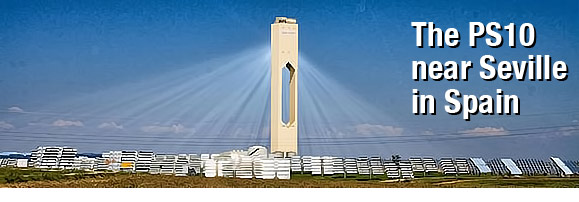Solar Towers: Concentrated Solar Radiation
Solar towers, also known as power towers, central receivers, or heliostat mirror power plants, are a type of solar furnace that uses solar energy to generate electricity. In this system the sun's power is collected by a large field of flat, movable mirrors. Sometimes there are thousands of mirrors. The mirrors, called heliostats, move so they can track the sun. They are focused on one single, fixed receiver that is located on top of a tall, central tower. Temperatures can be produced from 1,022 to 2,732F (550 to 1,500C) at the receiver.
The receiver collects all the energy and heat into a heat-transfer fluid that is flowing through it. In early power towers, this fluid was plain water. However, more recent models usually use molten salt, though liquid sodium, nitrate salt, and oil are also used. The heat energy held in the salt is used to boil water and make steam. This steam is used to generate electricity in a steam generator, usually located at the foot of the tower.
Molten salt can act as an efficient thermal storage medium for the heat collected in the solar tower. The heat can be stored for many hours or several days in this fashion. This storage medium is very important. It allows the solar towers to be operational for up to 65 percent of the year. The rest of the time, a backup fuel source is used. When there is no energy storage medium, solar towers can only be used for about 25 percent of the year.
In California there have been several solar tower projects. Solar One, which operated from 1982 to 1988, used water as a heat-transfer fluid in the receiver. It used 1,818 mirrors placed in semicircles around a tower that was 255 feet (78 meters) high. The mirrors focused the sunlight onto a boiler at the top. The use of water created problems for storage of the heat created and for running the turbine. Solar One was remade in 1992 to replace the water with molten salt. Despite this change, Solar One only functioned for a short time longer.
California funded another solar tower project that required an initial investment of $150 million. Solar Two operated from 1996 to 1999, had 10 megawatts of capacity, and also used molten salt. The success of Solar Two showed that the technology could work on a commercial basis.
Solar towers were built in other countries as well. The 15 MW Solar Tres Power Tower in Spain builds on these projects. In Spain the 11 MW PS10 solar power tower was recently completed. In South Africa, a solar power plant is planned with 4000 to 5000 heliostat mirrors, each having an area of 140 m². A site near Upington has been selected.
In June 2008, BrightSource Energy dedicated its Solar Energy Development Center (SEDC) in Israel's Negev Desert. The site, located in the Rotem Industrial Park, features more than 1,600 heliostats that track the sun and reflect light onto a 60 meter-high tower. The concentrated energy is then used to heat a boiler atop the tower to 550 degrees Celsius, generating steam that is piped into a turbine, where electricity can be produced.
The most ambitious project planned is a giant solar tower, one of the tallest structures in the world, out in the desert near Mildura, Victoria, Australia. The 154 megawatt power station will cost a total of A$420 million and will be built by Melbourne-based company Solar Systems, which says it will reduce greenhouse gas emissions by about 400,000 tonnes a year. The plant will generate clean electricity directly from the sun to meet the needs of more than 45,000 homes with zero greenhouse gas emissions.
Solar towers have one important advantage over other types of solar power: They continually generate electricity as long as they have a means of heat storage such as molten salt. This means that they can be used to provide reliable power for customers over a long period of time.
However, there are many drawbacks to solar towers as well. The technology is currently very costly. It might cost too much to make the power when considering the cost of building the tower itself. Moreover, the size of the tower makes it difficult to place. Solar towers take up a lot of space and are usually put in the desert or on empty land.
On the other hand, if this technology reaches maturity, solar towers could provide a cheap alternative source of power in the future. Although at present solar towers produce power that costs more than current electricity made with fossil fuels, as fossil fuels run out, the electricity made with fossil fuels will become more expensive and solar towers will become comparatively cheaper.
Solar Towers: Concentrated Solar Radiation copyright 2011 Digtheheat.com

